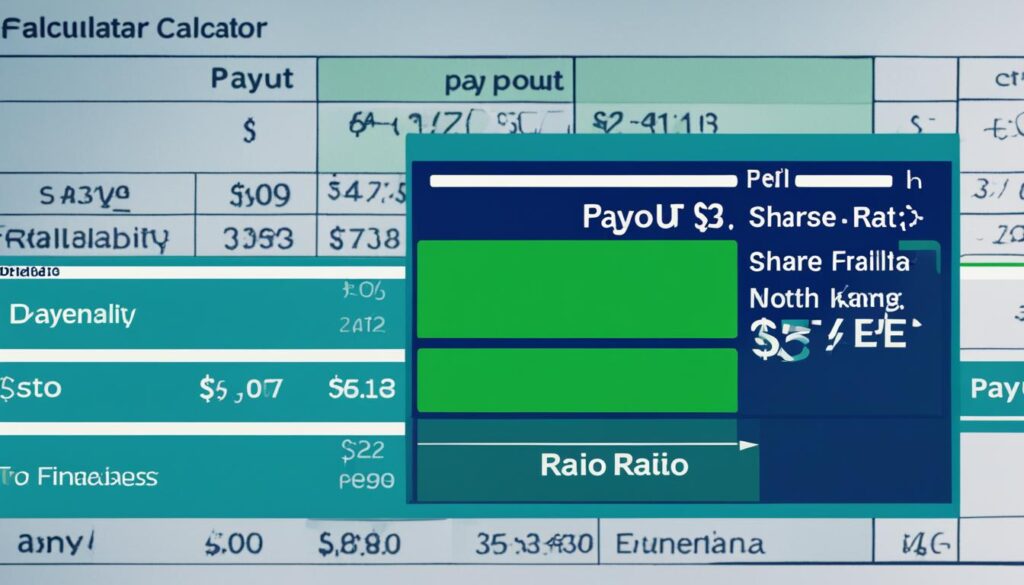As a financial analyst or investor, it’s crucial to learn about payout ratio and variance in finance. These two metrics provide insights into a company’s financial stability and risk assessment.
Payout ratio represents the proportion of a company’s earnings that are distributed to shareholders in the form of dividends. On the other hand, variance measures the variability and volatility of investment returns. Understanding these concepts and their formulas can help you make informed investment decisions and evaluate a company’s financial health.
Key Takeaways:
- Payout ratio and variance are important metrics for financial analysis.
- Payout ratio represents dividend distribution, while variance measures variability in investment returns.
- Understanding the formulas for these metrics is essential for evaluating a company’s financial health.
- Factors such as industry norms, economic conditions, and company-specific risks can influence payout ratio and variance.
- Analyzing payout ratio trends and managing variance can help investors make more accurate financial projections.
What is the Payout Ratio?
The payout ratio is a financial metric that measures the proportion of earnings distributed to shareholders as dividends. Simply put, it represents the percentage of earnings a company pays to its shareholders in dividends. This ratio is an essential indicator of a company’s financial health, as it reflects management’s policies and decisions on distributing earnings to shareholders.
To calculate the payout ratio, we take the dividends paid per share and divide it by earnings per share. The resulting percentage is the payout ratio, also known as the dividend payout ratio. For example, if a company earns $1 per share and pays a dividend of 30 cents per share, the payout ratio is 30%. This means that the company distributed 30% of its earnings to shareholders as dividends.
The payout ratio can offer valuable insights into a company’s dividend policy and financial stability. An excessively high payout ratio can indicate that a company is prioritizing dividend payments over reinvesting in the business, potentially limiting future growth opportunities. On the other hand, a low payout ratio may suggest that a company is retaining more earnings to invest in expansion and another potential opportunities. The appropriate payout ratio varies across industries, making it essential to compare the payout ratio of companies within the same sector.
Understanding Variance in Finance
Variance is a statistical measure of the degree of deviation between actual returns and expected returns. In finance, variance represents the volatility of investment returns, indicating how much the returns have fluctuated around the average.
Understanding variance is crucial for financial analysis because it provides insight into the risk associated with an investment. Investments with high variance are considered riskier than those with low variance as they are more likely to deviate significantly from the expected returns.
Variance can also help in risk assessment by providing a measure of the spread of possible outcomes. Investors and financial professionals use variance to calculate the level of risk in their portfolio and adjust their investment strategy accordingly.
Variance Formula Explained
| Variance Formula: | s2 = (∑(xi – x̄)2)/(n-1) |
|---|---|
| Variables: |
|
The variance formula might seem complex at first glance, but it’s a straightforward approach that provides insight into the variability of investment returns.
Therefore, understanding variance in finance is crucial for investment decisions and risk management. By analyzing variance, investors and financial professionals can assess the risk associated with an investment and make well-informed decisions.
The Formula for Payout Ratio
Calculating the payout ratio is an important metric in financial analysis. It represents the amount of dividends paid out to shareholders relative to the company’s net income. The payout ratio formula is as follows:
Payout Ratio = Dividends per Share / Earnings per Share
Let’s break down the components of the formula to better understand how it works. The dividends per share are simply the total amount of dividends paid out by the company divided by the number of outstanding shares. The earnings per share represent the company’s net income divided by the number of outstanding shares.
For example, if a company paid $1.50 in dividends per share and had earnings per share of $5.00, the payout ratio would be:
Payout Ratio = $1.50 / $5.00 = 0.30 or 30%
This means that the company paid out 30% of its earnings in dividends to shareholders.

By applying the payout ratio formula, investors and financial analysts can evaluate a company’s dividend policy and financial stability. A high payout ratio may indicate that a company is paying out more in dividends than it can afford, while a low ratio may suggest that a company has excess cash flow that could be distributed to investors in the form of dividends.
Calculating Variance
In finance, variance is a measure of the dispersion of returns around the average. It helps investors understand how much the returns of a particular investment can deviate from its expected value. Calculating variance involves a few steps, which we will detail below.
- Determine the mean return of the investment over a given period of time.
- Subtract the mean from each individual return to determine the deviation from the mean.
- Square each deviation value.
- Add up all of the squared deviation values.
- Divide the sum of squared deviations by the number of returns minus one.
The resulting value is the variance of the investment. It’s important to note that calculating variance can be time-consuming and complex, especially with a large dataset. However, it’s an essential part of financial analysis and risk assessment.
Let’s look at an example to demonstrate how to calculate variance:
| Year | Return (%) | Deviation from Mean (%) | Deviation Squared (%) |
|---|---|---|---|
| 2016 | 10 | -5 | 25 |
| 2017 | 15 | 0 | 0 |
| 2018 | 8 | -7 | 49 |
| 2019 | 12 | -3 | 9 |
| 2020 | 18 | 3 | 9 |
In this example, the mean return is (10+15+8+12+18)/5 = 12.6%. The sum of squared deviations is 92, and dividing this by 4 (number of returns minus one) gives us a variance of 23.
By understanding how to calculate variance, investors can better assess the risk and return of potential investments, leading to more informed and successful financial decisions.
Importance of Payout Ratio in Financial Analysis
At this stage, we need to understand why the payout ratio plays a crucial role in financial analysis. The payout ratio is an important fundamental metric that evaluates a company’s financial health by measuring the amount of dividends paid to shareholders in comparison to its net income. It is considered a reflection of a company’s dividend policy, indicating its willingness and ability to pay dividends to its shareholders.
For instance, a firm with a high payout ratio signifies a company that distributes the majority of its income to shareholders instead of reinvesting it in business operations. On the other hand, a low payout ratio indicates that the company utilizes most of its net income to reinvest in its operations or keep cash in its reserves.
Furthermore, the payout ratio provides insights on the company’s financial stability. By examining the payout ratio trends over time, analysts can assess its consistency and predictability in dividends payments. This information helps investors evaluate a company’s financial risk and make informed decisions regarding the investment’s suitability in their portfolio.
In summary, the payout ratio is a vital metric that enables us to analyze a company’s financial strength and dividend policy. Through this metric, financial professionals and investors can make well-informed decisions to maximize returns and manage risk effectively.
Significance of Variance in Risk Assessment
When assessing the risk of an investment, it’s important to take into consideration the variability and volatility of returns. This is where variance comes in. Variance measures the deviation of returns from their average value. It provides valuable insights into the extent to which returns fluctuate around their mean.
By analyzing variance, investors can get a better sense of the potential risks associated with a particular investment. Investments with higher variance tend to be more volatile and carry a greater degree of risk, while those with lower variance are generally considered less risky.
Moreover, variance can also help investors distinguish between two investments with similar average returns. An investment with a higher variance may have higher upside potential, meaning it could provide greater returns, but it could also be riskier. On the other hand, an investment with lower variance may have more stable returns but lower upside potential.
Thus, understanding the significance of variance is critical in risk assessment and plays an important role in making informed investment decisions.

Factors Affecting Payout Ratio
The payout ratio is influenced by a multitude of factors that are crucial in determining the dividend policy of a company. We shall examine these factors below.
Industry Norms
The industry a company operates in plays a significant role in the payout ratio. Certain industries, such as utilities and real estate investment trusts, have higher payout ratios than others due to stable earnings and steady cash flows.
Company Policies
Corporate policies also impact the payout ratio. A company may choose to pay out a larger portion of its earnings to reward shareholders or retain earnings to invest in growth opportunities. The payout ratio may be adjusted to support specific corporate objectives.
Profitability
A company’s ability to generate strong earnings and positive cash flows is a critical determinant of the payout ratio. Profitable companies are more likely to offer higher payout ratios, while those struggling financially may cut or suspend dividends entirely.
Growth Prospects
A company’s growth prospects also impact the payout ratio. A younger, high-growth company may reinvest earnings to fuel growth rather than pay dividends, while a mature company may have fewer growth opportunities and pay out a higher percentage of its earnings as dividends.
Understanding these factors is essential in evaluating a company’s dividend policy and financial health. In some cases, a high payout ratio may indicate that a company is in a mature, low-growth stage and may have fewer reinvestment opportunities. Alternatively, a low payout ratio may suggest that the company is in a high-growth phase and has significant opportunities to invest in its future.
Factors Contributing to Variance in Finance
Understanding the factors responsible for variance in finance is critical in managing investment risk. Variance measures the dispersion of returns around a mean, influenced by several factors:
- Market Volatility: Changes in market conditions can have a significant impact on an investment’s returns. Fluctuations in interest rates, inflation, and geopolitical events can lead to market volatility and contribute to variance.
- Economic Conditions: Economic factors such as GDP growth, employment rates, fiscal policies, and industry trends can have a considerable impact on a company’s stock prices and returns, leading to variance.
- Company-Specific Risks: Factors specific to a company such as management changes, financial performance, competition, and innovations can influence its stock returns, leading to variance.
- Investment Choices: The investment choices made by an individual or company can also contribute to variance. The level of diversification, asset allocation, and risk tolerance can significantly affect investment returns.
Investors and financial analysts need to consider the above factors carefully when assessing investment risks and making informed investment decisions.
Analyzing Payout Ratio Trends
Tracking the payout ratio trends of a company over time is crucial for investors and stakeholders to make informed decisions. By analyzing payout ratio trends, we can gain insights into a company’s dividend policy and financial health. A stable or increasing payout ratio indicates a company’s commitment to returning value to its shareholders, but it could also imply a lower reinvestment in the business for future growth. On the other hand, a decreasing payout ratio may suggest a company’s financial distress or a shift in strategy towards reinvestment in the business.
It is also essential to compare a company’s payout ratio with industry norms and its peers. A higher payout ratio than competitors might signify a company’s better financial performance, but it could also mean that the company has limited growth opportunities or is over-distributing dividends. Similarly, a lower payout ratio than peers could signal a company’s conservativeness or potential for future growth, but it could also mean that the company is not utilizing its cash reserves efficiently.
Therefore, analyzing payout ratio trends is not just about monitoring dividend payments, but it also provides valuable insights into a company’s financial performance and growth prospects.
Example of Payout Ratio Trends
| Year | Dividend per Share | Earnings per Share | Payout Ratio |
|---|---|---|---|
| 2021 | 0.80 | 2.50 | 32% |
| 2020 | 0.75 | 2.00 | 37.5% |
| 2019 | 0.70 | 1.80 | 38.9% |
For instance, the table above shows a company’s payout ratio trend over the past three years. Although the company has been increasing the dividend per share, the payout ratio has been decreasing, implying that the company is retaining more earnings for future growth. If the company’s cash reserves and growth prospects justify this strategy, the decreasing payout ratio could be a positive signal for investors. However, if the decreasing payout ratio is due to declining earnings, it could imply a worrying financial situation.
Managing Variance in Financial Planning
As we have discussed earlier, variance is a measure of risk, and managing it is crucial to ensure more accurate financial projections. While variance cannot be entirely eliminated, there are strategies that we can use to mitigate its impact on our financial plans.
We can start by diversifying our investments across different asset classes to reduce the impact of market volatility or any industry-specific risks. By spreading our investments, we can balance the positive and negative impacts of different investments and decrease our risk exposure.
Another strategy we can use is to invest in financial instruments with a low variance. This approach may include investing in fixed-income securities or blue-chip stocks that have historically shown stable returns over time. We can also consider investing in mutual funds or exchange-traded funds (ETFs) that offer diversification and risk management features.
Finally, we can use financial planning software, such as Monte Carlo simulations, to analyze and predict the impact of different scenarios on our financial plans. Such simulations can help us identify and manage potential risks and make necessary adjustments to our overall financial strategy.
To sum up, managing variance in financial planning is crucial for achieving our long-term financial goals. By diversifying our investments, investing in low-variance securities, and leveraging financial planning software, we can mitigate the impact of risk and uncertainty on our financial plans.
Conclusion
In conclusion, we have explored the basics of payout ratio and variance in finance. We have discussed their definitions, formulas, and importance in financial analysis. Payout ratio measures a company’s dividend payouts relative to its earnings, while variance measures the variability and volatility of investment returns.
We have also discussed the significance of analyzing payout ratio trends over time and managing variance in financial planning. By understanding these metrics and factors that influence them, investors and financial professionals can make well-informed decisions and manage risk effectively.
We hope this article has provided useful insights into payout ratio and variance, and their relevance in financial analysis. Stay tuned for more informative articles on financial concepts and strategies.
FAQ
Q: What is the payout ratio?
A: The payout ratio is a financial metric that measures the proportion of a company’s earnings that is distributed to shareholders in the form of dividends. It is calculated by dividing the dividends per share by the earnings per share and is expressed as a percentage.
Q: How do you calculate the payout ratio?
A: The payout ratio is calculated by dividing the dividends per share by the earnings per share. The formula is: Payout Ratio = Dividends per Share / Earnings per Share. The result is then multiplied by 100 to convert it into a percentage.
Q: What is variance in finance?
A: Variance is a statistical measurement that calculates the degree of dispersion or variability between numbers in a dataset. In finance, variance measures the risk and volatility of investment returns. It provides insights into how much the actual returns differ from the expected returns.
Q: How is variance calculated?
A: Variance is calculated by taking the difference between each data point and the mean of the dataset, squaring each difference, summing up all the squares, and dividing the total by the number of data points. The formula for variance is: Variance = Σ (X – μ)² / N, where X represents each data point, μ is the mean of the dataset, and N is the number of data points.
Q: Why is the payout ratio important in financial analysis?
A: The payout ratio is important in financial analysis as it provides insights into a company’s dividend policy and financial stability. A high payout ratio may indicate that a company is returning a significant portion of its earnings to shareholders, but it could also suggest a lack of retained earnings for growth and future investments. On the other hand, a low payout ratio may suggest that a company is retaining more earnings for potential expansion or to weather economic downturns.
Q: What is the significance of variance in risk assessment?
A: Variance is significant in risk assessment as it measures the variability and volatility of investment returns. A higher variance implies more significant fluctuations in returns, indicating higher overall risk. On the other hand, a lower variance suggests more stable and predictable returns, indicating lower risk.
Q: What factors affect the payout ratio?
A: Several factors can affect the payout ratio of a company. These factors include industry norms, company policies, profitability, growth prospects, funding requirements, and regulatory constraints. Companies with stable earnings, strong cash flows, and a commitment to regular dividend payments tend to have higher payout ratios.
Q: What factors contribute to variance in finance?
A: Variance in finance can be influenced by various factors, including market volatility, economic conditions, company-specific risks, and investment choices. Market volatility, driven by external factors such as geopolitical events or economic data releases, can significantly impact variance. Economic conditions, industry dynamics, and company-specific factors like competitive pressures and management decisions also contribute to variance. Additionally, the composition and performance of investment portfolios play a role in determining variance.
Q: Why is it important to analyze payout ratio trends?
A: Analyzing payout ratio trends over time helps investors and stakeholders assess a company’s dividend policy and financial stability. Increasing or stable payout ratios may suggest a company’s commitment to returning earnings to shareholders, while decreasing payout ratios may indicate a shift towards reinvesting earnings for growth. Analyzing payout ratio trends can provide valuable insights into a company’s financial health and future prospects.
Q: How can variance be managed in financial planning?
A: Managing variance in financial planning involves strategies to minimize and mitigate potential risks and uncertainties. Diversification, asset allocation, and risk management techniques such as hedging and using derivative instruments can help manage variance. Additionally, conducting thorough market research, analyzing historical data, and using scenario analysis can assist in making informed financial projections and reducing potential variations in outcomes.









